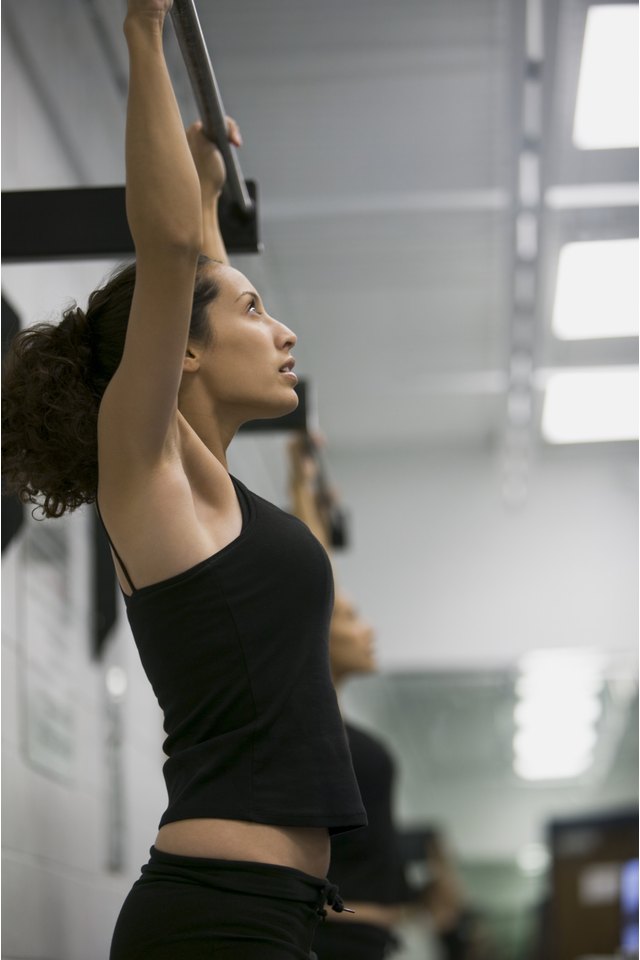Lats Vs. Pecs

Your lats, technically called your latissimus dorsi, are the broadest muscles in your back. Your pecs, which typically refers to the pectoralis major, are large muscles running across your chest. Your lats and pecs are the primary muscles for many shoulder movements, such as lifting, rotating and reaching. Different upper body exercises target these muscles differently.
Understanding Your Lats
Your lats are a large, flat muscles that originate around the crest of your pelvis and several lower vertebrae. They stretch diagonally across the width of your back and wrap around your torso before inserting into your humerus, or upper arm. They engage when you move your shoulder through a variety of motions including adduction, extension, transverse extension and internal rotation. They also assist with depressing, rotating and adducting your scapula, or shoulder blade.
Understanding Your Pecs
Your pecs are divided into two sections on each side of your chest, the upper and lower pecs. The upper part of your pec is known as the clavicular head of the pectoralis major. This is the smaller of your two pec muscles. It starts in the middle of your clavicle and stretches diagonally down to your humerus. It engages when you rotate your upper arm inward and perform activities such as chest flyes and straight arm raises. Your larger pec muscle, your pectoralis major sternal head, is your lower pec. It originates at your sternum and second through sixth ribs and stretches horizontally to your humerus. It engages when you rotate your upper arm inward, straighten your shoulder and do exercises such as pullups and chest flyes.
Comparing the Muscles
Various exercises recruit your lats and pecs differently. In exercises where you reach your arms from the front of your body up and over your head, such as the pullover, you target your pecs more than your lats, according to the “Journal of Applied Biomechanics." In moves where you begin with your arms over your head and pull them down along your sides, such as a pullup, you target your lats more than your pecs, according to the “Journal of Strength and Conditioning Research.”
Doing the Exercises
To do the pullover, lie face up on a bench while holding a dumbbell between your hands. Position the dumbbell directly over your chest; your elbows should be slightly bent. Lower the dumbbell over and beyond your head until you create a straight line between your torso and upper arms. Return to the starting position and repeat.
To perform the pullup, grasp an overhead bar with a wide, overhand grip. Pull your body up to the bar by bending your elbows. Pull up until your chin is above the bar then lower back down until your arms are fully extended. Repeat.
References
- Yoga Journal: Use Your Head About Shoulders
- ExRx.net: Latissimus Dorsi
- ExRx.net: Shoulder Articulations
- ExRx.net: Pectoralis Major (Clavicular Head)
- ExRx.net: Pectoralis Major (Sternal Head)
- Journal of Applied Biomechanics: Effects Of The Pullover Exercise On The Pectoralis Major And Latissimus Dorsi Muscles As Evaluated By EMG
- Journal of Strength and Conditioning Research: Surface Electromyographic Activation Patterns and Elbow Joint Motion During A Pull-Up, Chin-Up, Or Perfect-Pullup™ Rotational Exercise
- ExRx.net: Dumbbell Pullover
- ExRx.net: Pull-Up
Writer Bio
Fitzalan Gorman has more than 10 years of academic and commercial experience in research and writing. She has written speeches and text for CEOs, company presidents and leaders of major nonprofit organizations. Gorman has published for professional cycling teams and various health and fitness websites. She has a Master of Arts from Virginia Tech in political science and is a NASM certified personal trainer.
